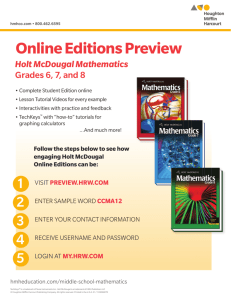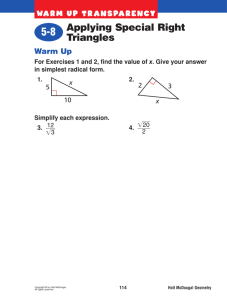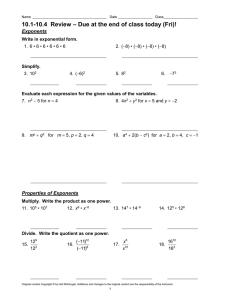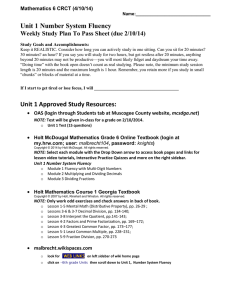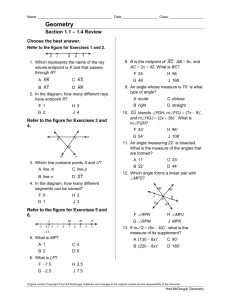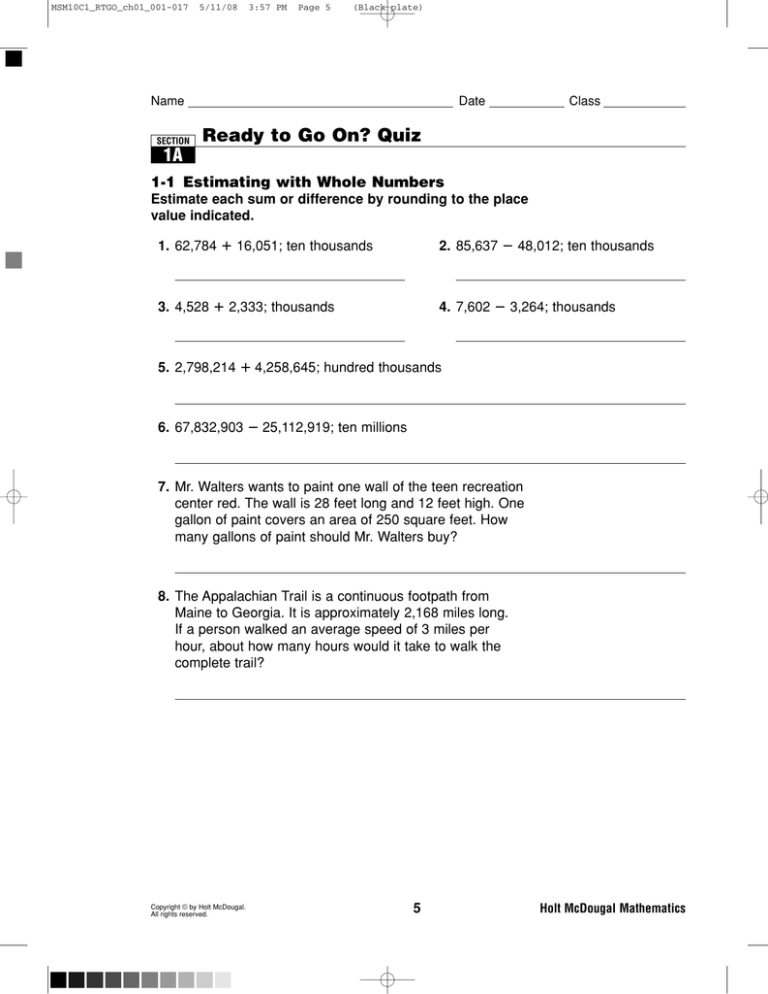
MSM10C1_RTGO_ch01_001-017
5/11/08
3:57 PM
Page 5
(Black plate)
Name
SECTION
Date
Class
Ready to Go On? Quiz
1A
1-1 Estimating with Whole Numbers
Estimate each sum or difference by rounding to the place
value indicated.
1. 62,784 16,051; ten thousands
2. 85,637 48,012; ten thousands
3. 4,528 2,333; thousands
4. 7,602 3,264; thousands
5. 2,798,214 4,258,645; hundred thousands
6. 67,832,903 25,112,919; ten millions
7. Mr. Walters wants to paint one wall of the teen recreation
center red. The wall is 28 feet long and 12 feet high. One
gallon of paint covers an area of 250 square feet. How
many gallons of paint should Mr. Walters buy?
8. The Appalachian Trail is a continuous footpath from
Maine to Georgia. It is approximately 2,168 miles long.
If a person walked an average speed of 3 miles per
hour, about how many hours would it take to walk the
complete trail?
Copyright © by Holt McDougal.
All rights reserved.
5
Holt McDougal Mathematics
MSM10C1_RTGO_ch01_001-017
5/11/08
3:57 PM
Page 6
(Black plate)
Name
SECTION
Date
Ready to Go On? Quiz
Class
continued
1A
1-2 Exponents
Write each expression in exponential form.
9. 6 6 6 6
10. 9 9
12. 3 3 3
11. 2 2 2 2 2 2
2
13. 10 10 10 10 10 14. 5 5 5 5 5 5
Find each value.
15. 42
16. 74
17. 19
18. 103
19. 251
20. 36
21. 91
22. 205
23. Anthony saves pennies in a jar. He starts by putting
1 penny in a jar. Then each day for 6 days, he puts
double the number of pennies he put in the jar from the
day before. How many pennies will he put in the jar
on the sixth day?
24. Mary finds a wishing well. With her first wish, she
asks for 8 new wishes. In the second round of
wishing, Mary takes each of her 8 wishes, and
asks for 8 new wishes. In the third round, Mary
takes each new wish and asks for 8 more, and
so on. How many wishes will Mary have after
4 rounds of wishing this way?
Copyright © by Holt McDougal.
All rights reserved.
6
Holt McDougal Mathematics
MSM10C1_RTGO_ch01_001-017
5/11/08
3:57 PM
Page 15
(Black plate)
Name
SECTION
Date
Class
Ready to Go On? Quiz
1B
1-3 Order of Operations
Simplify each expression.
1. 7 3 (8 5)
2. 33 6 4 2
3. (4 62) 10 7
4. 10 (8 4) 6
5. For the annual bake sale, Mrs. Robb’s class baked
7 batches of 12 cookies, 6 apple pies, 3 blueberry
pies, and 2 sheets of 10 lemon bars. Simplify
7 12 6 3 2 10 to find the total number of
items Mrs. Robb’s class made for the bake sale.
1-4 Properties and Mental Math
Simplify.
6. 7 8 13 22
7. 9 4 2
8. 5 7 10
9. 51 14 6 9
Use the Distributive Property to find each product.
10. 6 56
11. 3 46
12. 5 27
13. 8 33
Copyright © by Holt McDougal.
All rights reserved.
15
Holt McDougal Mathematics
MSM10C1_RTGO_ch01_001-017
5/11/08
3:57 PM
Page 16
(Black plate)
Name
SECTION
Date
Ready to Go On? Quiz
Class
continued
1B
1-5 Choosing a Method of Computation
Choose a solution method and solve.
Explain your choice.
Largest Texas Cities 2003
14. What is the total population of the three largest
cities in Texas?
15. Is the combined population of Austin and Fort
Worth more or less then the population of San
Antonio? About how much more or less?
City
Population
Houston
2,012,626
San Antonio
1,236,249
Dallas
1,210,393
Austin
681,804
Fort Worth
603,337
El Paso
592,099
Arlington
359,467
1-6 Patterns and Sequences
Identify a pattern in the arithmetic sequence and then find
the missing terms.
16. Position
Value of Term
1
2
3
4
7
19 31 43
5
6
7
Identify a pattern in each sequence. Name the missing terms.
17. 4, 16, 64,
, 1024,
18. 12, 24, 6,
, 3,
19. Jill strings beads for a necklace. She begins with
3 silver beads with a red spacer. She then strings
8 silver beads and a red spacer, followed by 13 silver
beads and a red spacer. If this pattern continues, how
many silver beads will she string next?
Copyright © by Holt McDougal.
All rights reserved.
16
Holt McDougal Mathematics
MSM10C1_RTGO_ch01_001-017
5/11/08
3:57 PM
Page 7
(Black plate)
Name
SECTION
1A
Date
Class
Ready to Go On? Enrichment
Earthworm Estimation and Exponents
The sixth and seventh grade classes of Palmer Middle School went
on a nature walk to collect earthworms. All earthworm collectors
kept a record of how many earthworms they caught, the length of
each worm, and the amount of soil they searched to find the worms.
1. If all the earthworms caught by the sixth graders
were lined up, they would stretch for 21,964 millimeters.
All the worms caught by the seventh graders would
stretch for 19,391 millimeters. Which class caught
more millimeters of worms?
About how many millimeters more?
2. The seventh graders found 3,127 earthworms. The
sixth graders found 2,915 earthworms. About how
many more worms did the seventh graders find?
The top collectors in the sixth grade were Jamie, Ed, and Lameisha.
Jamie collected 43 earthworms, Ed collected 34 earthworms, and
Lameisha collected 25 earthworms.
3. Write an expression for each student’s collection.
4. Who collected the most worms? How many did he or she collect?
The top collectors in the seventh grade were Liam, Rosa and Zachary.
Liam looked through 85 cubic inches of soil, Rosa looked through
94 cubic inches of soil, and Zachary looked through 46 cubic inches of soil.
5. Write an expression for each amount of soil.
6. Who looked through the least amount of soil? How much did he
or she look through?
7. Both classes explored a total of 625 square yards of land. Write
an expression that represents this amount of land. Then, write
the expression in exponential form.
Copyright © by Holt McDougal.
All rights reserved.
7
Holt McDougal Mathematics
MSM10C1_RTGO_ch01_001-017
5/11/08
3:57 PM
Page 17
(Black plate)
Name
SECTION
1B
Date
Class
Ready to Go On? Enrichment
Patterns with Milk Carton Boats
Every spring, Mr. Jacobson’s students make boats from milk cartons
collected from the school cafeteria and float them in a nearby lake.
Each boat draws its power from winding the propeller connected by
a rubber band. The table shows how far the boat will travel for each
number of times the rubber band is wound, or rotated.
Rotations
1
2
Distance (in.)
6
14 30 54
3
4
5
6
1. What is the difference between the first and
second distance?
Between the second and third distance?
Between the third and fourth distance?
2. How are each of the differences related?
3. Explain how you would find the next distance.
4. What are the missing terms in the table?
People became interested when they watched the boats moving
across the lake. Each day of the following week more people
brought their own milk carton boats to the lake.
Day
1
2
Boats on the lake
6
10 18
3
4
5
6
7
46 66
5. What is the difference between the first and second terms?
Between the second and third?
What number are these multiples of?
6. What are the missing terms?
Some students added shells in the back of their boats to see how
it would affect the distance their boats traveled. The table shows
their results.
Shells
Distance (in.)
1
2
3
4
346 256 166
7. Name a pattern you could use to find the next term.
8. What is the next term?
Copyright © by Holt McDougal.
All rights reserved.
17
Holt McDougal Mathematics
MSM10C1_RTGO_4up_266-332
SECTION
6/17/08
11:27 AM
Page 267
Ready to Go On? Quiz
Ready to Go On? Quiz
SECTION
1A
continued
1A
1-1 Estimating with Whole Numbers
1-2 Exponents
Estimate each sum or difference by rounding to the place
value indicated.
Write each expression in exponential form.
1. 62,784 16,051; ten thousands
9. 6 6 6 6
10. 9 9
11. 2 2 2 2 2 2
2
2. 85,637 48,012; ten thousands
80,000
40,000
3. 4,528 2,333; thousands
64
4. 7,602 3,264; thousands
7,000
92
12. 3 3 3
5,000
27
13. 10 10 10 10 10 14. 5 5 5 5 5 5
3
105
3
56
5. 2,798,214 4,258,645; hundred thousands
Find each value.
7,100,000
15. 42
16. 74
17. 19
18. 103
6. 67,832,903 25,112,919; ten millions
16
40,000,000
7. Mr. Walters wants to paint one wall of the teen recreation
center red. The wall is 28 feet long and 12 feet high. One
gallon of paint covers an area of 250 square feet. How
many gallons of paint should Mr. Walters buy?
1A
Holt McDougal Mathematics
Ready to Go On? Enrichment
64
4,096 wishes
6
Copyright © by Holt McDougal.
All rights reserved.
Holt McDougal Mathematics
Vocabulary
numerical expression
simplify
order of operations
Order of Operations
1. Perform operations in parentheses.
2. Find the values of numbers with exponents.
3. Multiply or divide from left to right as ordered in the problem.
4. Add or subtract from left to right as ordered in the problem.
200
Using the Order of Operations
Simplify the expression.
The top collectors in the sixth grade were Jamie, Ed, and Lameisha.
Jamie collected 43 earthworms, Ed collected 34 earthworms, and
Lameisha collected 25 earthworms.
9 (2 1) 33 5
9(
3. Write an expression for each student’s collection.
3 ) 33 5
Which operation should you perform first?
The addition inside the parentheses.
Jamie: 4 4 4, Ed: 3 3 3 3, Lameisha 2 2 2 2 2
93
4. Who collected the most worms? How many did he or she collect?
27 5
Which operation should you perform second?
Find the value of the number with an exponent.
Ed, 81 worms
3
The top collectors in the seventh grade were Liam, Rosa and Zachary.
Liam looked through 85 cubic inches of soil, Rosa looked through
94 cubic inches of soil, and Zachary looked through 46 cubic inches of soil.
27 5
Should you divide or multiply next? Explain.
divide; You begin on the left and move right.
81 5
Liam: 8 8 8 8 8; Rosa: 9 9 9 9;
6. Who looked through the least amount of soil? How much did he
or she look through?
subtraction.
The final operation is
The value of the expression 9 (2 1) 33 5 is
Zachary: 4 4 4 4 4 4
76 .
Consumer Application
Mr. and Mrs. Marsh are taking their four children to see a movie. The
price of admission is $7 for adults and $4 for children. Simplify the
expression, 2 $7 4 $4, to find the cost of tickets for the movie.
Zachary, 4,096 cubic inches
7. Both classes explored a total of 625 square yards of land. Write
an expression that represents this amount of land. Then, write
the expression in exponential form.
2
4
7
4
14
16
Which operation should you perform first?
14 16 30
5 5 5 5; 54
It will cost the Marsh family
7
multiplication
Which operation is next?
5. Write an expression for each amount of soil.
Copyright © by Holt McDougal.
All rights reserved.
3,200,000
Numerical expressions are mathematical phrases that include
only numbers and operation symbols. To find the value of a
numerical expression, you simplify the expression. When an
expression contains more than one operation, you can use the
order of operations to find out which operation to perform first.
sixth grade
3,000 millimeters
2. The seventh graders found 3,127 earthworms. The
sixth graders found 2,915 earthworms. About how
many more worms did the seventh graders find?
Copyright © by Holt McDougal.
All rights reserved.
9
Ready to Go On? Skills Intervention
1-3 Order of Operations
The sixth and seventh grade classes of Palmer Middle School went
on a nature walk to collect earthworms. All earthworm collectors
kept a record of how many earthworms they caught, the length of
each worm, and the amount of soil they searched to find the worms.
About how many millimeters more?
729
LESSON
Earthworm Estimation and Exponents
1. If all the earthworms caught by the sixth graders
were lined up, they would stretch for 21,964 millimeters.
All the worms caught by the seventh graders would
stretch for 19,391 millimeters. Which class caught
more millimeters of worms?
1,000
22. 205
24. Mary finds a wishing well. With her first wish, she
asks for 8 new wishes. In the second round of
wishing, Mary takes each of her 8 wishes, and
asks for 8 new wishes. In the third round, Mary
takes each new wish and asks for 8 more, and
so on. How many wishes will Mary have after
4 rounds of wishing this way?
700
SECTION
1
21. 91
25
2
5
20. 36
23. Anthony saves pennies in a jar. He starts by putting
1 penny in a jar. Then each day for 6 days, he puts
double the number of pennies he put in the jar from the
day before. How many pennies will he put in the jar
on the sixth day?
8. The Appalachian Trail is a continuous footpath from
Maine to Georgia. It is approximately 2,168 miles long.
If a person walked an average speed of 3 miles per
hour, about how many hours would it take to walk the
complete trail?
Copyright © by Holt McDougal.
All rights reserved.
2,401
19. 251
Holt McDougal Mathematics
Copyright © by Holt McDougal.
All rights reserved.
267
multiplication
Which operation should you perform next?
addition
$30 to see the movie.
8
Holt McDougal Mathematics
Holt McDougal Mathematics
MSM10C1_RTGO_4up_266-332
6/17/08
11:27 AM
Page 269
Ready to Go On? Skills Intervention
1-6 Patterns and Sequences
Ready to Go On? Problem Solving Intervention
1-6 Patterns and Sequences
LESSON
A sequence is an ordered set of numbers. Each number in the
sequence is called a term. In a sequence, there is often a pattern
between one term and the next. When the terms of the sequence
change by the same amount each time, the sequence is an
arithmetic sequence.
LESSON
Vocabulary
sequence
term
arithmetic sequence
3
9 12
5 7
Understand the Problem
1. What will you look for in the sequence to help you find the missing term?
a pattern
What number can you add to 3 to get 12?
What number can you subtract from 12 to get 7?
Make a Plan
A pattern is to add 9 to one term and subtract 5 from the next term.
9 24
3. Why do you think the pattern consists of more than one type of operation?
Possible answer: the numbers increase, then decrease,
Should you add or subtract to find the term after 15?
add
24 5 19
19 9 28
then increase, and so on.
Subtract to find the next term.
Solve
Add to find the next term.
The next three terms are
4. Look at the first two terms in the sequence. List 3 different things you can do to the
first term to get the second.
24 , 19 , and 28 .
Multiply the first term by 4, square it, or add 12 to it.
Completing a Sequence with Multiplication and Division
Identify a pattern in the sequence, and name the missing terms.
1, 4, 2, 8, 4, ■, 8, 32, ■, 64, …
4
2
1
4
4
What number can you multiply 1 by to get 4?
2
What number can you divide 4 by to get 2?
6. What should you do to the fifth term to get the sixth? If you do that, what is the
missing term?
Square it; 1,024
Look Back
A pattern is to multiply one term by 4 and divide the next term by 2.
4 16
7. What operation can be done to the second term to get the third and to the fourth
term to get the fifth?
Should you multiply or divide to find the first missing
term?
32
2 16
Divide by 2.
multiply
8. Does your answer for the missing term also fit the division part of the pattern?
Should you multiply or divide to find the second
Yes, if you divide 1,024 by 2, you get 512, which is the seventh term.
divide
16 and 16 .
missing term?
The two missing terms are
13
Copyright © by Holt McDougal.
All rights reserved.
SECTION
squaring
5. Which operation also works for the third and fourth terms?
Name a pattern for the sequence.
4
all seven numbers
2. Which numbers need to fit the pattern?
Name a pattern for the sequence.
15
Find the sixth term in the sequence.
4, 16, 8, 64, 32, ?, 512
Extending a Sequence with Addition and Subtraction
Identify a pattern in the sequence, and name the next three terms.
3, 12, 7, 16, 11, 20, 15, ■, ■, ■, …
12 To find missing terms in some sequences, it helps to think about different kinds of
operations.
Holt McDougal Mathematics
Ready to Go On? Quiz
SECTION
1B
14
Copyright © by Holt McDougal.
All rights reserved.
Ready to Go On? Quiz
Holt McDougal Mathematics
continued
1B
1-3 Order of Operations
1-5 Choosing a Method of Computation
Simplify each expression.
Choose a solution method and solve.
Explain your choice.
2. 33 6 4 2
1. 7 3 (8 5)
7
14. What is the total population of the three largest
cities in Texas?
1
3. (4 62) 10 7
4. 10 (8 4) 6
393
34
5. For the annual bake sale, Mrs. Robb’s class baked
7 batches of 12 cookies, 6 apple pies, 3 blueberry
pies, and 2 sheets of 10 lemon bars. Simplify
7 12 6 3 2 10 to find the total number of
items Mrs. Robb’s class made for the bake sale.
Largest Texas Cities 2003
Population
Houston
2,012,626
San Antonio
1,236,249
Calculator; 4,459,268; the numbers are large
Dallas
1,210,393
and would take a long time to add on paper.
Austin
681,804
Fort Worth
603,337
El Paso
592,099
Arlington
359,467
15. Is the combined population of Austin and Fort
Worth more or less then the population of San
Antonio? About how much more or less?
113
City
Estimation; About 50,000 more; the problem doesn’t ask for a specific
answer, so I can round to find the answer.
1-4 Properties and Mental Math
Simplify.
6. 7 8 13 22
1-6 Patterns and Sequences
7. 9 4 2
50
Identify a pattern in the arithmetic sequence and then find
the missing terms.
72
8. 5 7 10
16. Position
9. 51 14 6 9
350
Value of Term
80
Use the Distributive Property to find each product.
10. 6 56
17. 4, 16, 64,
Copyright © by Holt McDougal.
All rights reserved.
Copyright © by Holt McDougal.
All rights reserved.
4
5
6
7
, 1024,
18. 12, 24, 6,
Holt McDougal Mathematics
Copyright © by Holt McDougal.
All rights reserved.
269
, 3,
multiply by 2, then divide by 4; 12, 6
19. Jill strings beads for a necklace. She begins with
3 silver beads with a red spacer. She then strings
8 silver beads and a red spacer, followed by 13 silver
beads and a red spacer. If this pattern continues, how
many silver beads will she string next?
264
15
3
multiply by 4; 256, 4096
13. 8 33
135
19 31 43
Identify a pattern in each sequence. Name the missing terms.
138
12. 5 27
2
7
add 12; 55, 67, 79
11. 3 46
336
1
16
18
Holt McDougal Mathematics
Holt McDougal Mathematics
MSM10C1_RTGO_4up_266-332
SECTION
1B
6/17/08
11:27 AM
Page 270
Ready to Go On? Enrichment
Ready to Go On? Skills Intervention
2-1 Variables and Expressions
LESSON
Patterns with Milk Carton Boats
Every spring, Mr. Jacobson’s students make boats from milk cartons
collected from the school cafeteria and float them in a nearby lake.
Each boat draws its power from winding the propeller connected by
a rubber band. The table shows how far the boat will travel for each
number of times the rubber band is wound, or rotated.
Rotations
1
2
Distance (in.)
6
14 30 54
3
4
5
A variable is a letter or symbol that represents a quantity that
can change. A constant is a quantity that does not change. An
algebraic expression contains one or more variables and may
contain operation symbols. To evaluate an algebraic expression,
you substitute a number for the variable and then find the value
by simplifying.
6
Evaluate the expression to find the missing values in the table.
Between the second and third distance?
Between the third and fourth distance?
2. How are each of the differences related?
3. Explain how you would find the next distance.
4. What are the missing terms in the table?
8 in.
16 in.
24 in.
They are multiples of 8.
Multiply 4 by 8, add 54.
86, 126
People became interested when they watched the boats moving
across the lake. Each day of the following week more people
brought their own milk carton boats to the lake.
1
2
Boats on the lake
6
10 18
3
4
5
6
6. What are the missing terms?
Distance (in.)
9
What is the value of x 9, when x 81?
72
8
What is the value of x 9, when x 72?
63
7
What is the value of x 9, when x 63?
In the expression,
81 9 72 9 x is the variable. 9 is the constant.
9
8
7
t
Evaluating Expressions with Two Variables
A classroom has 3 rows of seats. How many seats are there if there
are 3 seats in each row? 4 seats? 5 seats?
r
s
r s
3
3
33
What does r represent?
What does s represent?
3
4
34
3
5
35
number of rows
number of seats in a row
What does the expression r s represent?
total number of seats
4
How many seats are there if there are 3 seats in each row?
346 256 166
8. What is the next term?
17
3 3 9 seats
3 4 12 seats
5 seats in each row? 3 5 15 seats
4 seats in each row?
subtract 90
76
7. Name a pattern you could use to find the next term.
Copyright © by Holt McDougal.
All rights reserved.
81
56
can write 56 t as .
4
8
4
30, 90
Some students added shells in the back of their boats to see how
it would affect the distance their boats traveled. The table shows
their results.
3
Substitute for x in x 9.
63 9 46 66
Between the second and third?
2
x9
You can write multiplication and division expressions without using
the symbols and . You can write t 4 as t • 4, t(4), or 4t. You
What number are these multiples of?
1
x
Fill in the missing values in the table.
7
5. What is the difference between the first and second terms?
Shells
variable
constant
algebraic expression
evaluate
Evaluating Algebraic Expressions
1. What is the difference between the first and
second distance?
Day
Vocabulary
Holt McDougal Mathematics
Ready to Go On? Problem Solving Intervention
2-1 Variables and Expressions
18
Copyright © by Holt McDougal.
All rights reserved.
Holt McDougal Mathematics
Ready to Go On? Skills Intervention
2-2 Translating Between Words and Math
LESSON
LESSON
To evaluate an algebraic expression, substitute a number for the
variable, and then find the value. Some expressions contain more
than one variable.
In word problems, you need to identify the action to translate words
to math. There are several different ways to write math expressions
with words.
Shauna is planning a rectangular garden for her yard. If the width
of the garden is 3 feet, what will be the area of the garden in square
feet for lengths of 3, 4, 5, or 6 feet?
Put together
or
combine
Action
You can multiply length and width to find the area.
Operation
Add
Find how
much more
or less
Put together
groups of
equal parts
Separate into
equal groups
Subtract
Multiply
Divide
Understand the Problem
1. In the problem, what is the quantity that can change?
Complete the table.
the length of the garden
2. In the problem, what quantity does not change?
the width of the garden
Operation
Algebraic
Expression
x 19
t 11
6 • h or (6)(h) or
6h
p 4 or 4
Words
Make a Plan
3. What is the formula for the area of a rectangle?
Alw
x
• x plus 19
to
Solve
• the sum of
4. Fill in the missing values in the table below.
l
w
l w
3
3
9
4
3
12
5
3
15
6
3
18
• 19 added
x and 19
• 19 more
than x
• 11 subtracted
from t
• t minus 11
• the difference
t and 11
• 11 less
of
•6
times h
p
•p
by
• h multiplied by
6
divided
4
• the quotient of
p and 4
• the product of
6 and h
than t
• take away 11
from t
Translating Words into Math
Write the phrase as a numerical expression.
834 plus 127
What operation is represented by the action “plus”?
Look Back
addition
5. Look back at the question being asked and answer it.
834
The area of a 3-foot long garden 3 3 9 ft 2. The area of a 4-foot
Complete the phrases.
Copyright © by Holt McDougal.
All rights reserved.
19
subtraction
In the expression b 17, what operation is being performed?
2
3 5 15 ft . The area of a 6-foot long garden 3 6 18 ft .
Copyright © by Holt McDougal.
All rights reserved.
Write the correct operational symbol.
Translating Math into Words
Write two phrases for the expression b 17.
long garden 3 4 12 ft 2. The area of a 5-foot long garden 2
127
Holt McDougal Mathematics
Copyright © by Holt McDougal.
All rights reserved.
270
b
minus
17 or 17
20
less than
b
Holt McDougal Mathematics
Holt McDougal Mathematics

